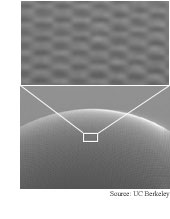|
NEWS
|
Plastic
bug eye
 A plastic
insect eye that mimics biological compound insect
eyes by packs 8,370 microscopic lenses into a 2.5 millimeter
hemisphere. The bug-eye lens provides a wide field of
view and could be used for optical data storage, medical
diagnostics and surveillance. (Biologically Inspired Artificial
Compound Eyes, Science, April 28, 2006)
A plastic
insect eye that mimics biological compound insect
eyes by packs 8,370 microscopic lenses into a 2.5 millimeter
hemisphere. The bug-eye lens provides a wide field of
view and could be used for optical data storage, medical
diagnostics and surveillance. (Biologically Inspired Artificial
Compound Eyes, Science, April 28, 2006)
Meaningful Wikipedia
A proposed
Wikipedia extension provides meaning-based tags for
the communally-written online encyclopedia. A tag could
indicate, for example, that a link from the entry on laptop
computers to the entry on personal computers means that
laptop computers are a type of personal computer. The
semantically-enhanced links would allow computer programs
to interpret the meaning of Wikipedia entries. (Semantic
Wikipedia, World Wide Web Conference (WWW2006), Edinburgh,
Scotland, May 22-26, 2006)
Web as computer
A proposed software framework uses Web services,
which run software programs over the Web, and the semantic
Web, which allows computers to understand the meaning
of Web content, within the eXtensible Markup Language
(XML) to turn Web documents into software programs and
the Web as a whole into a gigantic distributed computer.
The Semantic
fXML framework, one of several similar proposals,
would make it possible for software agents to find information
and make transactions automatically. (One Document to
Bind Them: Combining XML, Web Services, and the Semantic
Web, World Wide Web Conference (WWW2006), Edinburgh, Scotland,
May 22-26, 2006)
Terahertz biochip
A biochip
that includes a terahertz radiation source scans substances
to determine their makeup. The device could be used to
rapidly detect illegal drugs, to identify DNA samples
and to study biological molecules like proteins. (Terahertz
Biochip for Illicit Drug Detection, Conference on Lasers
and Electro-Optics/Quantum Electronics and Laser Science
(CLEO/QELS) 2006, Long Beach, California, May 21-26)
Rubber micro microscope
A tiny
rubber microscope includes a rubber lens. The low-cost
microscope is designed to be integrated into biochips
for use in handheld medical diagnostic and biological
research devices. (Microfabricated rubber microscope using
soft solid immersion lenses, Applied Physics Letters,
April 24, 2006)
Watery wires promise super memory
An experiment shows that water
can stabilize the switchable electronic states of
wires as small as three nanometers in diameter. If such
nanowires were used as memory elements they could lead
to data storage capacities thousands of times higher than
those of today's storage devices. (Ferroelectric Phase
Transition in Individual Single-Crystalline BaTiO3 Nanowires,
Nano Letters, April 12, 2006) |
FEATURES
|
View
from the High Ground: Cornell's Jon Kleinberg
Six degrees of separation, buying gasoline
by the molecule, the science of popularity, all just getting
along online, intellectual prosthetics, Big Science, making
up questions, and telling stories.
|
How
It Works: Quantum computing: qubits
Photons, electrons and atoms, oh my! These particles are
the raw materials for qubits, the basic building blocks
of quantum computers. |
|
 |
News RSS feed 
Blog RSS feed 
Bookshelf RSS feed

New: TRN's
Internet Services
TRN's Jobs Center
|
| |
|
| |
|
| |
"In
most areas of science and technology, the origins
of new breakthroughs can still be found in the work
of a small number of people -- or even a single
person -- working at their own pace on their own
questions, pursuing things that interest them. "
- Jon Kleinberg, Cornell University |
|
| |
|
| |
Thanks
to Kevin from
GoldBamboo.com
for technical support |
|

